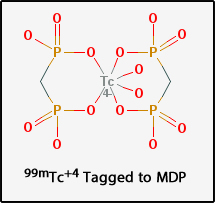- Looks at the isotopes of iodine
- 123I, 124I, 125I, 127I, and 131I
- There is no biological difference when replacing one isotope from the other because they "behave" the same. (Question - Do the different iodines behave differently (metabolically) when injected into a human system?
- However, the main consideration with the different iodines relates to: the type of radiation being emitted, the amount of energy associated with it, and its T1/2
- Consider - Therapy or diagnostic? Which of the above iodines would you use?
- Should radiation dosimetry be considered?
- This is where a radioactive isotope exchanges with a stable isotope (Example - 123I, 124I, 125I, 127I, and 131I)
- Example of this process123I → 127I
- If you had a 1:1 ratio then the exchange that would occur would be 50%. A 20:1 ratio would yield a 95% exchange
- Example of the exchange where one of the paired iodines is radioactive: R-H + I2 → R-I + HI
- Example of radiopharmaceutical - I123 or I131MIBG
- This technique also applies to areas of invitro nuclear medicine. Example 125I(T3/T4)
- A radionuclide is labeled to a molecule that has a known biological function
- Usually has a covalent or coordinate covalent bond
- Tagging of the radionuclide to the molecule of interest is unusual (doesn't occur in nature)
- Chelation - is a process in which one atom donates a pair of elections to the other (foreign) atom. Usually a transition metal
- Examples include:51Cr-labeled RBCs, 18FDG, 99mTcDTPA, and most 99mTc- labeled compounds

- Bi-functional chelating agent occurs when a radionuclide shares a union with another macromolecule (ex. Protein, MoAb)
- Either of two methods can done meet this process
- 99mTc chelate method - a chemical is used to establish the chelation. Diamidoldithiol, cyclam are examples of these types of agents, where a bond is established between the chelating agent and the protein
- Indirect chelate-antibody method
- Bi-functional chelating agent is conjugated with a macromolecule (Ex. MoAb), reacts with a metal-chelate-macromolecule complex
- Example 111In-DTPA-MoAb or 111In-DTPA-Octreotide
- Radioactive material is introduced into a growth medium in which (Ex) bacteria grows
- Radioactive metabolites are produced as a byproduct
- Radioactive metabolites are chemically removed and can be applied
- 57Co-B12 as an example
- Recoiled atoms or ions are produced in a target material by particles that are initially emitted from a radioactive material. These particles cause the atoms in the surrounding medium to recoil and rebonds generating a different molecule
- This process is rarely done, has a low specific activity of the bound product
- Occurs in a highly energetic process, (Ex) β
- Particle ionize surrounding atoms causing ions to form resulting in new new bonds with other compounds
- Low yield
Return to the Table of Content